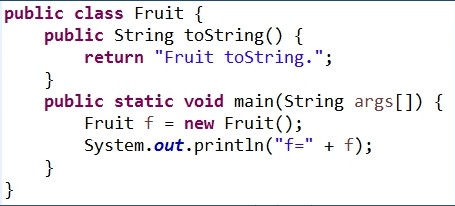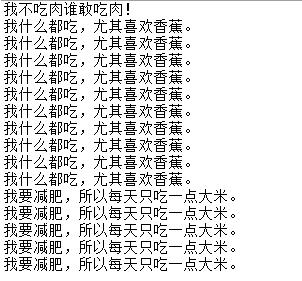繼承與多態 - 課後作業
1 . 繼承條件下的構造方法調用
class Grandparent
{
public Grandparent()
{
System.out.println("GrandParent Created.");
}
public Grandparent(String string)
{
System.out.println("GrandParent Created.String:" + string);
}
}
class Parent extends Grandparent
{
public Parent()
{
//super("Hello.Grandparent.");
System.out.println("Parent Created");
// super("Hello.Grandparent.");
}
}
class Child extends Parent
{
public Child()
{
System.out.println("Child Created");
}
}
public class TestInherits
{
public static void main(String args[])
{
Child c = new Child();
}
}
截圖:


第一個是沒有用super,第二個用到了super,super()括號中有參數,所以就調用了有參數的基類構造方法。當把super的語句放到後面的時候,程序報錯,構造函數調用必須是構造函數中的第一個語句。
父類與子類之間構造方法的調用關系修改Parent構造方法的代碼,顯式調用GrandParent的另一個構造函數,這句調用代碼必須是第一句,不然會報錯。通過 super 調用基類構造方法,必須是子類構造方法中的第一個語句。
2 . 為什麽子類的構造方法在運行之前,必須調用父類的構造方法?能不能反過來?為什麽不能反過來?
構造函數是一種特殊的方法 。主要在創建對象時初始化對象,
構造一個對象,先調用其構造方法,來初始化其成員函數和成員變量。
子類擁有父的成員變量和方法,如果不調用,則從父類繼承而來的成員變量和成員方法得不到正確的初始化。
不能反過來調用,因為父類不知道子類有什麽變量,而且子類也得不到初始化的父類變量,導致程序運行出錯!
3 . A@1c5f743的運行結果
package kehou5;
public class ExplorationJDKSource { /** * @param args */ public static void main(String[] args) { System.out.println(new A()); } } class A{}
運行截圖:

原因:使用javap –c命令反匯編這個程序,發現main方法實際上調用的是:public void println(Object x),這一方法內部調用了String類的valueOf方法。
valueOf方法內部又調用Object.toString方法:
public String toString() {
return getClass().getName() +"@" +
Integer.toHexString(hashCode());
}
hashCode方法是本地方法,由JVM設計者實現:public native int hashCode();
4 . 註意最後一句,為什麽一個字串和一個對象“相加”,得到以下結果

結果;

原因:在“+”運算中,當任何一個對象與一個String對象,連接時,會隱式地調用其toString()方法,默認情況下,此方法返回“類名 @ + hashCode”。為了返回有意義的信息,子類可以重寫toString()方法。
5 . 自行編寫代碼測試以下特性:在子類中,若要調用父類中被覆蓋的方法,可以使用super關鍵字。
class Parent
{
public void show()
{
System.out.println("111");
}
}
class Child extends Parent
{
public void show()
{
super.show();
System.out.println("222");
}
}
public class test {
public static void main(String [] args)
{
Child c = new Child();
c.show();
}
截圖:

結果分析:super方法在子類覆蓋方法類使用,只有這樣才能調用父類中被覆蓋的方法,並且super語句放在子類覆蓋方法第幾句都行
6 .
現在有三個類: class Mammal{} class Dog extends Mammal {} class Cat extends Mammal{}
針對每個類定義三個變量並進行初始化 Mammal m=null ; Dog d=new Dog(); Cat c=new Cat();
下列語句哪一個將引起編譯錯誤?為什麽?哪一個會引起運行時錯誤?為什麽?
m=d; d=m; d=(Dog)m; d=c; c=(Cat)m;
class Mammal{}
class Dog extends Mammal {}
class Cat extends Mammal{}
public class TestCast
{
public static void main(String args[])
{
Mammal m;
Dog d=new Dog();
Cat c=new Cat();
m=d;
//d=m;
d=(Dog)m;
//d=c;
//c=(Cat)m;
}
}
d=m;d=c;
不正確 子類對象可以直接賦給基類變量。
基類對象要賦給子類對象變量,必須執行類型轉換,
其語法是:子類對象變量=(子類名)基類對象名;
c=(Cat)m
不正確 轉換混亂。如果類型轉換失敗Java會拋出以下這種異常:ClassCastException
7 . 運行以下測試代碼
public class ParentChildTest {
public static void main(String[] args) {
Parent parent=new Parent();
parent.printValue();
Child child=new Child();
child.printValue();
parent=child;
parent.printValue();
parent.myValue++;
parent.printValue();
((Child)parent).myValue++;
parent.printValue();
}
}
class Parent{
public int myValue=100;
public void printValue() {
System.out.println("Parent.printValue(),myValue="+myValue);
}
}
class Child extends Parent{
public int myValue=200;
public void printValue() {
System.out.println("Child.printValue(),myValue="+myValue);
}
}
運行結果:

原因:通過強制類型轉換子類的字符將父類的字符覆蓋了
計算機是不會出錯的,之所以得到這樣的運行結果也是有原因的,那麽從這些運行結果中,你能總結出Java的哪些語法特性?
當子類與父類擁有一樣的方法,並且讓一個父類變量引用一個子類對象時,到底調用哪個方法,由對象自己的“真實”類型所決定,這就是說:對象是子類型的,它就調用子類型的方法,是父類型的,它就調用父類型的方法。
如果子類與父類有相同的字段,則子類中的字段會代替或隱藏父類的字段,子類方法中訪問的是子類中的字段(而不是父類中的字段)。如果子類方法確實想訪問父類中被隱藏的同名字段,可以用super關鍵字來訪問它。
如果子類被當作父類使用,則通過子類訪問的字段是父類的。
8 . 這種編程方式有什麽不合理的地方嗎?
public class Zoo
{
public static void main(String args[])
{
Feeder f = new Feeder("小李");
// 飼養員小李餵養一只獅子
f.feedLion(new Lion());
// 飼養員小李餵養十只猴子
for (int i = 0; i < 10; i++)
{
f.feedMonkey(new Monkey());
}
// 飼養員小李餵養5只鴿子
for (int i = 0; i < 5; i++)
{
f.feedPigeon(new Pigeon());
}
}
}
class Feeder
{
public String name;
public Feeder(String name)
{
this.name = name;
}
public void feedLion(Lion l)
{
l.eat();
}
public void feedPigeon(Pigeon p)
{
p.eat();
}
public void feedMonkey(Monkey m)
{
m.eat();
}
}
class Lion
{
public void eat()
{
System.out.println("我不吃肉誰敢吃肉!");
}
}
class Monkey
{
public void eat()
{
System.out.println("我什麽都吃,尤其喜歡香蕉。");
}
}
class Pigeon
{
public void eat()
{
System.out.println("我要減肥,所以每天只吃一點大米。");
}
}
算法太復雜。
結果:

繼承與多態 - 課後作業
